
Do you have a question about the Eaton Cutler-Hammer DS-416 and is the answer not in the manual?
| Brand | Eaton |
|---|---|
| Model | Cutler-Hammer DS-416 |
| Category | Circuit breakers |
| Language | English |
Critical warning about DS/DSL breakers being protective devices and not to be operated outside nameplate ratings.
Details the components of the basic breaker assembly including chassis, control panel, and operating mechanism.
Explains the construction and function of arc chutes with vertical steel splitter plates.
Lists optional components available upon order, such as trip attachments and auxiliary switches.
Mentions accessories like levering crank and Amptector Test Kit supplied as required.
Instructions for receiving and handling circuit breakers, whether shipped assembled or separately.
Guidance on proper storage conditions to protect insulation from dirt, water, and condensation.
Approximate weights for various DS and DSL circuit breakers and fuse trucks.
Overview of the process to withdraw the breaker from its compartment for examination.
Instructions on positioning the compartment rails for breaker withdrawal.
Steps to remove shipping braces before the first breaker withdrawal.
Guidelines for safely lifting the breaker using the accessory lifting adapter.
Instructions to examine the breaker's major components before operation.
Guidance for performing dry-run practice operations on the breaker.
Detailed steps for using the levering device to move the breaker between positions.
Instructions on how to manually charge the closing springs.
Conditions and procedure for closing the circuit breaker.
Methods for opening the circuit breaker, including manual and automatic tripping.
Procedure for moving the breaker to the test position.
Procedure for moving the breaker to the connected position.
Instructions for withdrawing the breaker for inspection.
Checks to ensure arc chutes and barriers are properly installed.
Information on Amptector trip unit settings and coordination with load.
Final steps to place the breaker into service.
Overview of the breaker's operation and its main functional parts.
Detailed explanation of the spring-charged stored energy operating mechanism.
Differentiates between manual and power-operated breaker closing and tripping facilities.
Details on manual charging and closing, and power-operated charging/closing.
Lists manual and electrical methods for tripping the breaker.
Explains the function of the levering device and its four normal positions.
Explains the automatic mechanical interlocking for safety and proper sequences.
Describes conditions preventing closing and charging in the REMOVE position.
Details interlocks preventing withdrawal and ensuring the breaker is open.
Explains interlocks allowing no-load operation with separated primary contacts.
Describes interlocks preventing disconnection/withdrawal of a closed breaker.
In-depth explanation of the interlock system preventing closing during levering.
Overview of three-pole assemblies for DS breakers and their construction.
Details on the construction of moving contact members and blades.
Description of stationary contacts, fingers, and their blow-on action.
Close-up view and general design of arc chutes for various breaker types.
Overview of sensors, Amptector trip unit, and actuator in the tripping system.
Details on the Amptector II-A trip unit, its controls, and characteristics.
Description of the Amptector I-A trip unit, including optional ground fault protection.
Information on ground current protection and its connection requirements.
Explanation of the discriminator circuit for instantaneous tripping on faults.
Guidelines for servicing the Amptector trip unit, including dial adjustment and warnings.
Description of the actuator's role in producing mechanical force to trip the breaker.
Explanation of how sensors provide load current output to the Amptector trip unit.
Overview of DSL breakers as combinations of DS breakers and current limiters.
Details on DSL current limiter ratings and their function in extending interrupting ratings.
Explanation of the visual indicator for blown current limiters in DSL breakers.
Information on DS-3200 and DS-4000 fuse trucks for Class L fuses.
Procedure for installing fuse trucks in series with DS circuit breakers.
Steps for replacing Class L fuses in the fuse truck.
Function of the blown fuse indicator on fuse trucks and its relation to breaker tripping.
Description of fixed breakers, lacking levering device and primary disconnects.
Explanation of dummy elements as isolating disconnecting switches.
Importance of regular inspection and maintenance for high reliability breakers.
Recommendations for the frequency of general inspection and lubrication.
Guidance on inspecting contacts, barriers, and arc chutes for wear and damage.
Specific inspection points for contacts and dimensions on these breaker types.
Specific inspection points for fixed main contacts on DS-632/DS-840.
Procedures for replacing moving and stationary contacts.
Instructions for replacing contacts on the DS-206 model.
Instructions for replacing contacts on DS-416 and related models.
Guidance on inspecting arc chutes for erosion and when to replace them.
Checks for missing parts, loose fasteners, and general wear on breaker components.
Inspection of the oscillator pawl for wear or damage.
Procedure for adjusting the trip latch overlap for proper tripping.
Procedure for adjusting the open position stop on DS-632 breakers.
Instructions for adjusting contact engagement for main and arcing contacts.
Details on reassembling and adjusting the levering mechanism components.
Recommended intervals for lubricating the circuit breaker based on operations.
Specifies locations and type of lubricant (Molykote BR-2 Plus) for breaker parts.
Guidance on identifying and ordering replacement parts.
Information on identifying parts for DS-416S and DS-206S models.
Details for identifying parts specific to the DS-416S breaker.
Details on major differences and parts for the DS-206S breaker.


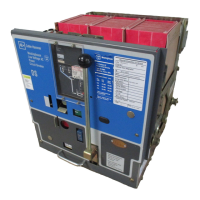

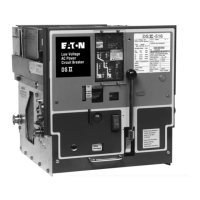
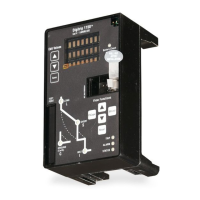
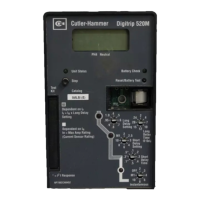

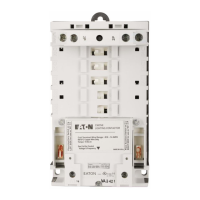



